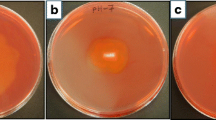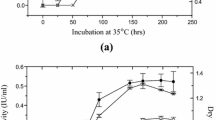Abstract
A cellulolytic wild-type strain of Penicillium purpurogenum was isolated from a soil sample in southern Chile. It grew best at 28°C from an inoculum of 4×107 spores/100 ml medium. Highest endoglucanase activity was with Sigmacell as carbon source and corn steep liquor as nitrogen source. Wheat bran enhanced the production of endoglucanase and β-glucosidase. The enzymes in the crude supernatants were stable up to 50°C and between pH 4.4 and 5.6 for 48 h.
Similar content being viewed by others
References
Anon. 1978 Report AF 149/5-GB. Bagsvaerd, Denmark: Novo-Nordisk.
Brown, J.A., Collin, S.A. & Wood, T.M. 1987a Enhanced enzyme production by the cellulolytic fungus Penicillium pinophilum, mutant strain NTG III/6. Enzyme and Microbial Technology 9, 176–180.
Brown, J.A., Collin, S.A. & Wood, T.M. 1987b Development of a medium for high xylanase and β-glucosidase production by a mutant strain (NTG III/6) of the cellulolytic fungus Penicillium pinophilum. Enzyme and Microbial Technology 9, 355–360.
Desphande, V., Seeta, R., Mishra, C. & Rao, M. 1988 Stability and recovery of Penicillium funiculosum cellulases under use conditions. Applied Biochemistry and Biotechnology 19, 11–19.
Hidalgo, M., Steiner, J. & Eyzaguirre, J. 1992 β-Glucosidase from Penicillium purpurogenum: purification and properties. Biotechnology and Applied Biochemistry 15, 185–191.
Hoffman, R.M. & Wood, T.M. 1985 Isolation and prtial characterisation of a mutant of Penicillium funiculosum for the saccharification of straw. Biotechnology and Bioengineering 27, 81–85.
Jain, S., Parriche, M., Durand, H. & Tiraby, G. 1990 Production of polysaccharidases by a cellulase-pectinase hyperproducing mutant (Pol6) of Penicillium occitanis. Enzyme and Microbial Technology 12, 691–696.
Joglekar, A.V. & Karanth, N.G. 1984 Studies on cellulase production by a mutant Penicillium funiculosum UV-49. Biotechnology and Bioengineering 26, 1079–1084.
Mandels, M. 1982 Cellulases. Annual Reports on Fermentation Processes 5, 35–78.
Mandels, M. & Weber, J. 1969 The production of cellulases. Advances in Chemistry Series 95, 391–414.
Mandels, M., Hontz, L. & Nystrom, J. 1974 Enzymatic hydrolysis of waste cellulose. Biotechnology and Bioengineering 16, 1471–1493.
Mandels, M. & Andreotti, R.E. 1978 Problems and challenges in the cellulose to cellulase fermentation. Process Biochemistry 13, 6–13.
Musalem, M., Steiner, J. & Contreras, I. 1984 Producción de celulasas por hongos aislados de maderas y suelos del sur de Chile. Boletín Micológico 2, 17–25.
Nelson, N. 1944 A photometric adaptation of the Somogyi method for the determination of glucose. Journal of Biological Chemistry 153, 375–380.
Poutanen, K., Rättö, M., Puls, J. & Viikari, L. 1987 Evaluation of different microbial xylanolytic systems. Journal of Biotechnology 6, 49–60.
Sasaki, H., Kamagata, Y., Takao, S., Matangkasombut, P. & Bhumiratana, A. 1983 Selection and classification of active cellulose decomposing fungi. Microbial Utilisation of Renewable Resources 3, 65–76.
Sternberg, D. 1976a A method for increasing cellulase production by Trichoderma viride. Biotechnology and Bioengineering 18, 1751–1760.
Sternberg, D. 1976b Production of cellulase by Trichoderma. Biotechnology and Bioengineering Symposium 6, 35–53.
Tansey, M.R. 1971 Agar diffusion assay of cellulolytic ability of thermophilic fungi. Archiv für Mikrobiologie. 77, 1–11.
Tischler, M., Hirte, W.F. & Schulz, G. 1989 Development of a cellulase complex for distillery purposes by optimisation of cultivation conditions from selected Penicillium strains. Zentralblatt für Mikrobiologie 145, 411–426.
Wood, T.M. 1968 Cellulolytic enzyme system of Trichoderma koningii. Biochemical Journal 109, 217–227.
Additional information
J.Steiner and C. Socha are with the Facultad de Ciencias Quimicas y Farmacéuticas, Universidad de Chile, Casilla 233, Santiago 1, Chile; J. Eyzaguirre is with the Laboratorio de Bioquímica, Pontificia Universidad Católica de Chile, Casilla 114-D, Santiago, Chile.
Rights and permissions
About this article
Cite this article
Steiner, J., Socha, C. & Eyzaguirre, J. Culture conditions for enhanced cellulase production by a native strain of Penicillium purpurogenum . World Journal of Microbiology & Biotechnology 10, 280–284 (1994). https://doi.org/10.1007/BF00414863
Revised:
Accepted:
Issue Date:
DOI: https://doi.org/10.1007/BF00414863




